 |
 |





 |
 |
 |
 |
 |
 |
Consultants unveil concepts for I-35W/Hwy 62 Crosstown corridor
|
 |
 |
 |
Mn/DOT staff and the
Parsons, Brinckerhoff, Quade and Douglas, Inc.consulting firm presented
draft concepts for the I-35W/Hwy 62 Crosstown project to an advisory committee
on Nov. 14.
|
No major roadway closures during construction and increased roadway capacity
are the benchmarks of the proposed concepts for the I-35W/Hwy 62 Crosstown project
that the legislature delayed a year.
Parsons, Brinckerhoff, Quade and Douglas, Inc., the consultant hired to study
the project, and Mn/DOT staff presented the proposed concepts today to the Crosstown
Highway Study Advisory Committee.
Commissioner Elwyn Tinklenberg told the committee, made up of local and state
government officials, that he has directed Mn/DOT staff to pursue the new concept
alternatives.
"Whatever we do will likely remain as we have created it for a long time,"
Tinklenberg said. "These alternatives are a significant improvement over
our current plan."
The two PB concepts are very similar. In general, they provide for two full
lanes of traffic both westbound and eastbound on Hwy 62 through the commons
area. The original plan only called for one lane in each direction. I-35W has
two lanes plus a high occupancy vehicle lane running through the commons. The
increased capacity northbound is due to the addition of a general-purpose lane
to accommodate the traffic from eastbound Hwy 62 that wants to go northbound
I-35W. A total of five lanes, four general-purpose lanes plus an HOV lane, are
proposed north of the commons section. Mn/DOT’s original plan only had four
lanes north of the intersection.
Another major improvement is the reduction of road closures during construction.
The consultant alternatives have various closures that may last from two to
eight weeks. The original Mn/DOT plan had closures of certain movements that
would last for up to four years.
The Parsons, Brinckerhoff concepts also contain parts of the original plan.
They separate the two roadways in the commons area, eliminating the traffic
weave. They will add an HOV lane all the way through the commons, area as well.
The differences in the two Parsons, Brinckerhoff proposals concern use of traffic
management barriers in the commons area. To get these improvements, the project
will require more right-of-way, possibly eight to 10 homes, and an increase
in costs of 30 to 50 percent. The additional right-of-way will allow Mn/DOT
to keep traffic moving through the construction zone during the project.
According to the Commissioner, the original plan was a very good plan, considering
the parameters within which it had to operate.
"Mn/DOT’s plan was the best compromise acceptable at the time to all
who were involved, including the cities of Richfield and Minneapolis,"
Tinklenberg said.
"This is a project that now balances the needs of the community surrounding
the project with the transportation needs of the region," he said. "It
achieves the direction of the legislature—that we determine if the project could
be undertaken more quickly and with less disruption to motorists, while also
adding capacity."
The state legislature ordered a one-year moratorium on reconstruction of the
I-35W/Highway 62 (Crosstown) commons area and for Mn/DOT to contract with a
consultant to conduct the study. The concepts presented today will be refined
based on input from the Crosstown Highway Study Advisory Team and reported to
the Legislature’s Transportation Policy and Finance Committees by Jan. 15, 2002.
For more information visit the Crosstown
Study Web site.
By Kevin Gutknecht and Jeanne Aamodt
|
back

|
 |
Transit services connect riders with community
|
 |
 |
Editor’s note: This is one in a series of articles looking back on the department’s
first 25 years—remembering the people, issues and cultural forces that have
shaped the agency and the milestones Mn/DOT has achieved.
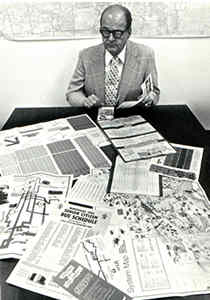 |
|
Dwight Bonin, a retired
Mn/DOT transit official, looks over a deskful of schedules from transit
services throughout the state. File photo
|
For increasing numbers of Minnesotans, the day begins with a bus ride.
At about the same time the day’s first NorthStar Commuter Coach bus pulls into
the Fifth Street Garage in Minneapolis, other transit buses in places such as
Duluth and St. Cloud are heading out on their early morning runs as well. So,
too, are transit buses in smaller cities such as Moorhead, Litchfield and Upsala.
Though they vary in size, scope and ridership, each transit system serves a
common purpose—enabling Minnesotans to get to work, to school, to whatever activity
that enriches their lives or that of their communities.
In the year 2000, 64 of the state’s 87 counties provided countywide transit
services. Nine counties had municipal service only while seven counties lacked
any public transit service.
Service continues to grow. In 2002, transit service will start in the city
of Worthington and in Crow Wing and Nicollet counties.
It wasn’t always so.
In 1990, for example, 21 counties had no public transit service. Thirty-six
counties had countywide service, while 23 counties had municipal service only.
The rapid growth in transit service can be attributed to many sources, chief
among them advocacy made by Mn/DOT’s Office of Transit.
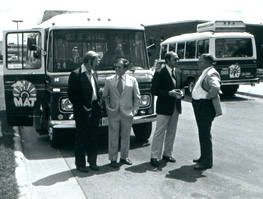 |
|
The start of fixed-route
bus service by Metropolitan Area Transit in Moorhead in 1976 drew visits
from state and local officials. Since 1976 the service has grown to include
special routes for students to Moorhead State University and other areas
schools and combined operations with Fargo, N. D. to provide dial-a-ride
service for elderly people and people with disabilities in the Fargo-Moorhead
metropolitan area. File photo
|
Mn/DOT’s involvement with transit started with the department’s creation in
1976. At that time, only the Twin Cities and a
handful of other cities offered daily, fixed-route bus service. A few counties
offered dial-a-ride services for their residents. Often, nursing homes and adult
activity centers were the only ones providing transit service for their clients.
Since then, however, transit services have proliferated statewide. Their numbers
and levels of service mushroomed fueled by the needs of those who chose not
to drive or those who weren’t able or couldn’t afford to drive.
The Minnesota Legislature provided a boost to transit in 1978 when it appropriated
$4 million to spur system development, said Donna Allan, Mn/DOT’s transit director.
"Awareness grew of the need for older people or people who don’t drive
to remain mobile in order to meet their own needs and to remain active in their
communities," said Allan. "Policymakers also realized that access
to services such as health care, social services and shopping help keep people
at home and out of nursing homes or migrating to larger cities," she said.
"Transit often enables people to remain in the communities that most value
them."
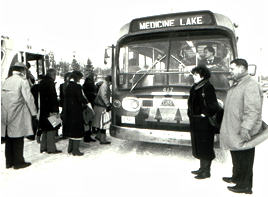 |
|
Donna Allan, director,
Office of Transit, and Bill Crawford, retired Metro Division engineer,
visit a park-and-ride lot serving transit commuters in the Twin Cities
northern suburbs. File photo
|
"Recent years have seen a shift in transit to include a wider spectrum
of users," Allan said. "While historically elderly people were the
primary transit users, the systems now carry a mix of workers, high school and
college students and others who use the bus as their primary means of transportation
or instead of buying a second car."
Several cities—including St. Cloud, Duluth and Moorhead—operate services especially
geared to transport students to colleges in those areas, she said.
Randy Halvorson, assistant director, Program Delivery Group, said Minnesota’s
success with transit stems from a comprehensive plan it developed and growing
support from legislators and county officials for transit services.
Transit providers, he said continue to seek ways to improve their services.
Several county services, he said, have linked with others, for example, to transfer
passengers from one area to another and to market their service to wider audiences.
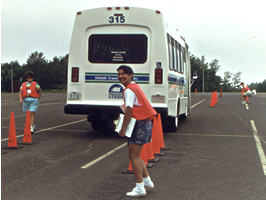 |
|
Teresa Hyde, Traffic
Management Center, a former Office of Transit employee, judges the backing
ability of a driver during one of the transit roadeos held each year.
The roadeos bring drivers together to compete, sharpen their skills and
receive training. Photo by Deb Fick
|
In the Morrison County city of Upsala, a small transit system there often makes
a major difference in the lives of community members.
"For many riders, our service is basically a lifeline," said Steve
Johnson, transit director. "The bus enables people to get out of their
homes and to come and go without depending on family, friends or neighbors.
Instead of being homebound, the bus gives them a measure of independence and
enables them to participate in community life."
Maxine Bolstrom, a long-time driver for the service, said the bus has become
an integral part of community life.
"People here don’t have to ask their kids for rides to the doctor or the
dentist or to get their groceries," she said. "The bus lets people
get into town and do their own thing," she said.
Moorhead’s Metropolitan Area Transit service started the same year Mn/DOT was
created—1976. Since then, the service has made a difference in the lives of
thousands of system users, said Lori Van Beck, system coordinator.
"For people who can’t drive or can’t afford a car, the fixed-route bus
system helps people get to jobs so they can work and provide for their families,"
she said.
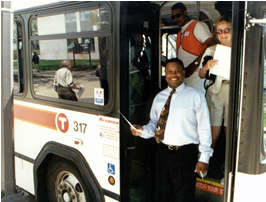 |
|
Checking out a new
Metro Transit bus during a B-BOP (Bike, Bus or Pool) Day celebration in
St. Paul are (from the top) Jarvis Keys, Transit; Deb Fick, Maintenance,
and Ben Osemenam, Advanced Transportation Systems. Photo by Kevin Walker
|
The system also coordinates a dial-a-ride service that serves mainly elderly
people and a joint paratransit system with the city of Fargo to improve their
ability to travel throughout the Fargo-Moorhead metro area.
The Meeker County city of Litchfield started its transit service in 1995.
Brandon Pietsch, transit director, said the service provides its mainly elderly
riders with mobility and access to services they need.
"We’ve had a lot of positive feedback," he said. "People tell
us they tell the city council and the county commissioners this is one of the
best programs they’ve ever done."
One of the newest transit services is the first actually operated by Mn/DOT—the
NorthStar Commuter Coach that provides bus service daily between Elk River and
Minneapolis. Since service began Oct. 1, ridership continues to increase as
word of the service spreads.
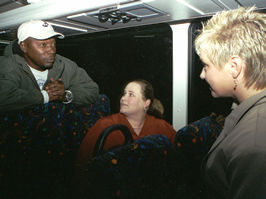 |
|
NorthStar Commuter Coach
passenger Stephanie Korupp of Elk River (center) chats before her bus
departs for Minneapolis with driver John Hamilton and Sue Siemers, Transit.
The new commuter service on the Hwy 10 corridor has drawn hundreds of
riders since its started on Oct. 1. The service is the first to be operated
by Mn/DOT. Photo by Craig Wilkins
|
Hundreds of daily riders, happy to exchange an hour or longer drive for a relaxed
ride on the bus, welcomed the service.
One new rider, Lori Paul of Elk River, was on the bus the first day service
started.
Paul was so frustrated by her long commute that she rented an apartment near
her office in St. Paul and went home only on weekends.
"With the new bus service, I can read or listen to the radio," she
said. "Instead of stressing out from the traffic, I get to my office ready
to work."
As Halvorson notes, "The work with communities and transit is a joyful
part of this job. The result is grassroots involvement that resulted in the
most extensive rural public transit system in the U.S."
By Craig Wilkins
|
back

|
 |
Task force makes short-term changes to increase program delivery capabilities
|
 |
 |
Three weeks ago Mn/DOT established the Resource and Momentum Task Force to
develop short- and long-term strategies to help realign department resources
to assure timely delivery of projects while helping the department advance the
"Shaping Our Future" vision of a products and services organizational
model.
"We are pursuing this model because we live in an increasingly fast-paced
world and Mn/DOT must adjust to the challenges or someone else—the Legislature
or private consultants—will do it for us," according to Deputy Commissioner
Doug Weiszhaar.
"Pressures driving the evolution of Mn/DOT’s future organization have
been considered by the Senior Management Team. These include local and national
trends, perspectives on how transportation will change, recommendations on what
the organization will look like and setting actions that will chart our course,"
said Weiszhaar.
The Resource and Momentum Task Force is pursuing short- and long-term strategies
to realign resources and ensure timely delivery of the department’s work.
Short-term recommendations recently approved by Commissioner Tinklenberg and
the Senior Management Team include a $3 million allocation for increasing consultant
services, employee overtime and acceleration of right-of-way processes to meet
production schedules. Also approved is an internal assessment and realignment
of the ROW function.
Mn/DOT has assigned Al Pint to this task. He will direct the change process
necessary to complete ROW work in the current highway program and redefine the
ROW functions of the districts, Metro Division and the Office of Land Management.
This includes possible outsourcing of ROW activity to accommodate a highway
construction program that exceeds $400 million annually.
Pint will work with Karl Rassmussen, director, Office of Land Management, and
district and Metro officials to evaluate and change current ROW processes.
Pint reports to the Streamlining Oversight Team comprised of Doug Weiszhaar,
deputy commissioner; Pat Hughes, director, Program Support Group, and Jim Swanson,
assistant commissioner, Program Delivery Group.
The Resource and Momentum Task Force will now shift its work to develop long-term
recommendations based on information gathered in recent weeks from Mn/DOT office
directors.
"Mn/DOT has a long tradition of being a national and international leader
in transportation. To maintain that leadership, Mn/DOT must adapt to a changing
environment. Realigning our resources is a part of the process," said Randy
Halvorson, assistant director, Program Delivery.
Employees are encouraged to contact task force members with questions: Bruce
Biser, Bruce Briese, Dawn Hagen, Randy Halvorson, Rick Kjonaas, Marthand Nookala,
Scott Peterson, Nelrae Succio and Gary Thompson. Copies of the "Shaping
our Future" plan are available from Kathy Klecker at 651/296-1343.
|
back

|
 |
Mn/DOT, Rochester to use design-build, best value to reconstruct Hwy 52
|
 |
 |
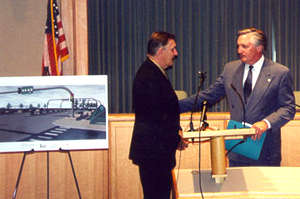 |
Commissioner Elwyn Tinklenberg,
right, and Rochester Mayor Chuck Canfield announced the Hwy 52 design-build,
best value project on Nov. 8. The announcement took place in the council
chambers of the Rochester-Olmsted County Government Center. Photo by
Brian Jergenson
|
Mn/DOT and the city of Rochester announced Nov. 8 that a "design-build,
best value" construction technique will be used to reconstruct Rochester’s
"Gateway"—the stretch of Hwy 52 north of 55th Street NW to Hwy 63.
"We're using the design-build, best value concept to reconstruct Hwy 52 as
a means of accelerating the improvement to Minnesota's transportation system,"
said Commissioner Elwyn Tinklenberg. "The new, innovative concept will give
Mn/DOT, the city and the contractor a better opportunity to achieve the best
value in terms of cost, staging and timing."
The design-build, best value construction method means one contractor will
manage both the final design and construction of the project. Under design-build,
construction can begin before all design details are finalized.
"This provides a better opportunity to begin construction earlier, and
improves the likelihood the project will be completed in a shorter time frame,"
said Mark Krebsbach, acting District 6 transportation engineer.
Without design-build, construction on the Hwy 52 project was not scheduled
to begin until 2004. Mn/DOT now expects to award a contract in the summer or
fall of 2002, with construction slated to begin in 2003.
The Hwy 52 reconstruction through Rochester is Mn/DOT’s first design-build,
best value construction project. The new technique became available to Mn/DOT
after action by the state legislature, and is one additional tool that Mn/DOT
will use to keep Moving Minnesota.
|
back

|
 |
Willmar bypass opens
|
 |
 |
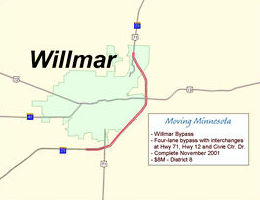 |
The new Willmar bypass
opened in four-lane splendor Nov. 13. The bypass runs along the eastside
of Willmar on Hwy 71 and Hwy 23. Map courtesy of District 8
|
The "new" Willmar bypass opened in four-lane splendor Tuesday, Nov.
13.
The bypass, which runs along the eastside of Willmar on Hwy 71 and Hwy 23,
has been a long time coming.
Plans for the project began in the 1960s when Mn/DOT was still called the Highway
Department.
"Nobody had heard of the IRC (interregional corridors) system or the Moving
Minnesota funding initiative but many of the goals were the same—to use the
highway system to help move people and goods as efficiently as possible,"
notes Dave Trooien, District 8 transportation engineer.
Mn/DOT surveyed locations in 1964 and held the first public hearings for the
planned four-lane bypass in 1971. The new highway, considered important for
improving connections in central Minnesota, was to be complete by 1974.
But the district was in for a disappointment, Trooien said.
Budget shortfalls in the 1970s and a financial crisis in the early 1980s forced
a change of plans. Ultimately the department scaled the project back, leaving
the northbound lanes unpaved and designing the bypass interchanges for a two-lane
highway.
Work on the bypass resumed in September 2001 with an $8 million project to
construct the remaining two lanes and upgrade the interchanges to a four-lane
design.
Next week—30 years after that first public hearing—Mn/DOT will formally celebrate
the bypass’s journey through time with a silver ribbon-cutting ceremony. On
hand at the Nov. 20 event will be Commissioner Elwyn Tinklenberg, local legislators
and dignitaries, and Mn/DOT retiree Ken Madole, who was the district engineer
when the bypass was put on the back burner.
"We plan a big celebration," says Sandy East district public affairs
coordinator. "The Hwy 23 bypass is important to the city of Willmar and
it is an important interregional corridor. Completion of the four-lane bypass
is part of larger District 8 and District 3 plans to improve Hwy 23 between
Richmond and I-94."
By Kay Korsgaard
|
back

|
 |
New ice-melting solutions, snowplows draw news media to Metro Division event
|
 |
 |
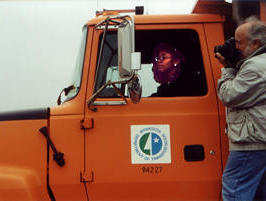 |
Toni Coleman, St.
Paul Pioneer Press reporter, drives a Mn/DOT snowplow while Craig
Borck, Pioneer Press photographer, captures the view from the running
board. Ten media outlets attended the Metro Division’s 2001 Snow and Ice
Media Expo at the Cedar Avenue Truck Station on Nov. 13. Photo by Kevin
Walker
|
Cameras rolled and so did the snowplows at Metro Division’s Snow and Ice Media
Expo on Nov. 13 at the Cedar Avenue Truck Station.
Ten media outlets accepted Mn/DOT’s invitation to learn about snow and ice
removal and about two new products to be used this year. News media members
also had a chance to drive a snowplow.
The Metro Division patterned this first winter maintenance expo after the construction
kickoffs that occur annually.
Commissioner Elwyn Tinklenberg, Metro Division Engineer Dick Stehr and Metro
Division Maintenance Engineer Sue Mulvihill presented an overview of Mn/DOT’s
snow and ice removal program. Mark Fischbach, transportation program specialist,
highlighted two new products that will be used this season—Caliber M1000 and
blue salt.
Caliber M1000, a liquid the color and consistency of vegetable oil, is made
from corn. Like salt, it is an ice-melting material. However, Fischbach said,
it’s effective to minus 30 or 40 degrees—about 25 to 35 degrees lower than salt.
And, because it’s liquid, Caliber M1000 adheres to the roadway better than salt,
he said.
Metro Division maintenance crews will test Caliber M1000 at three locations
in the Twin Cities—the I-394 reversible lanes, the Hwy 52 Lafayette Bridge and
the I-35E Cayuga Bridge. Test results will measure bare pavement times and accidents
to track the liquid’s effectiveness for reducing frost and black ice on the
roadways.
 |
|
Ron Schloer, transportation
specialist, holds a handful of blue salt for media photographers. The
blue-tinted salt was one of two new products that Mn/DOT will use in snow
and ice removal this winter. Photo by Kevin Walker
|
Blue salt is treated with Caliber M1000. Besides alerting maintenance workers
to how much salt is being applied over the white snow, the salt’s blue dye absorbs
sunlight and melts snow and ice more quickly than non-tinted salt. Maintenance
workers will be able to use 30 percent less of the blue-tinted salt, thereby
reducing road and equipment corrosion.
Several attendees drove one of Metro Division’s 252 snowplows around the truck
station.
Ron Schloer, one of the plow drivers guiding the volunteers, said that motorists
in general don’t give plows the respect they deserve.
"Driving the plow isn’t hard," Schloer said. "It’s driving the
plow in traffic that’s hard."
To see how
the news media covered the event, click on Mn/DOT’s daily news clippings
(available to intranet users only).
By Sue Stein
|
Statewide
snow and ice operations at a glance
-
131,100: Number of miles of streets and highways,
including on 11,900 miles of state trunk highways
850: Number of Mn/DOT snowplows
-
$50 million: Amount Mn/DOT spends on snow and
ice removal during an average winter
-
46: Number of inches of snowfall Minnesota
annually receives
Source: Metro Division Fact Sheet, 2001-2002
|
|
back

|
 |
Clarkowski takes mobility to Pre-Letting section
|
 |
 |
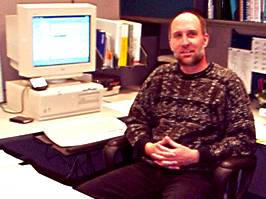 |
Todd Clarkowski has
been appointed acting director of the Pre-Letting section.
|
Todd Clarkowski has been appointed acting director of the Pre-Letting section
while Mark Krebsbach serves as acting District Engineer for District 6.
Clarkowski has more than 12 years of experience with Mn/DOT, most recently
serving as Metro Division Office of Program Delivery area engineer for Chisago
County and the northern two-thirds of Washington County. His previous Mn/DOT
positions were in the Office of Technical Support consultant agreements unit,
Metro Division Final Design and Mn/DOT’s graduate engineer program.
Before he came to Mn/DOT, Clarkowski worked in private industry for grading
contractors and a survey contractor. He earned a bachelor’s degree from the
University of Wisconsin-Platteville.
Clarkowski can be reached at 651/296-3268, M.S. 692.
|
back

|
 |
Hagen appointed Communications assistant office director
|
 |
 |
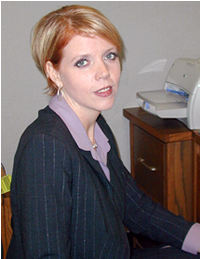 |
Dawn Hagen has been
appointed assistant office director for the Office of Communications and
Public Relations.
|
Dawn Hagen has been appointed assistant office director for the Office of Communications
and Public Relations. She replaces Lucy Kender, who now serves as the media
leader in OCPR’s Media and Community Relations unit.
Hagen has more than 12 years of experience in public sector communications,
including 11 years with the Minneapolis Community Development Agency, where
she was the public information manager. Her last position prior to Mn/DOT was
director of communications for the city of Elgin, Illinois. She has also worked
as a consultant for several local businesses and served as a national board
member of the City, County Communications Marketing Association.
Hagen has a master’s degree in business communications from the University
of St. Thomas.
Hagen can be reached at 651/297-2602, M.S. 150. Kender can be reached at 651/297-7961.
|
back

|
 |
Exhibits, speakers sought for transportation conference
|
 |
 |
Show folks at the 2002 Transportation Conference how you are Moving
Minnesota.
The transportation conference planning committee is now accepting requests
for conference exhibit space, report Sue Stein and Mary Meinert, committee co-chairs.
They advise offices to request an exhibit booth early since space is limited.
The committee will do its best to honor all requests.
Visit the Transportation
Conference Web site to complete an exhibit application. Stein also encouraged
employees to submit concurrent session ideas—including Mn/DOT activities, partnership
accomplishments or external speakers—for the conference.
The deadline for submitting concurrent session topics is Nov. 23. The deadline
for requesting exhibit space is Dec. 14.
Check the transportation conference Web site periodically for updates.
|
back

|
|
 |
|



